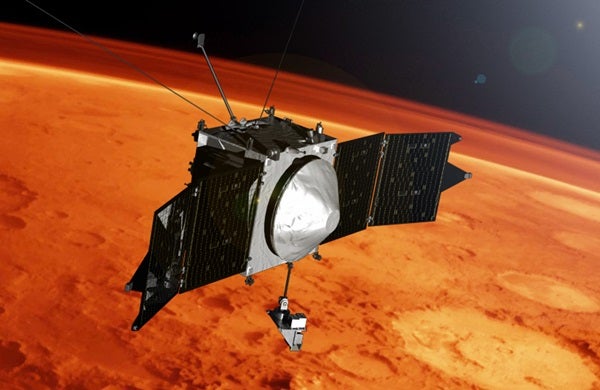The findings are among the first returns from NASA’s Mars Atmosphere and Volatile Evolution (MAVEN) mission, which entered its science phase November 16. The observations reveal a new process by which the solar wind can penetrate deep into a planetary atmosphere. They include the first comprehensive measurements of the composition of Mars’ upper atmosphere and electrically charged ionosphere. The results also offer an unprecedented view of ions as they gain the energy that will lead to their escape from the atmosphere.
“We are beginning to see the links in a chain that begins with solar-driven processes acting on gas in the upper atmosphere and leads to atmospheric loss,” said Bruce Jakosky from the University of Colorado in Boulder. “Over the course of the full mission, we’ll be able to fill in this picture and really understand the processes by which the atmosphere changed over time.”
On each orbit around Mars, MAVEN dips into the ionosphere — the layer of ions and electrons extending from about 75 to 300 miles (120 to 480 kilometers) above the surface. This layer serves as a kind of shield around the planet, deflecting the solar wind, an intense stream of hot high-energy particles from the Sun.
Scientists have long thought that measurements of the solar wind could be made only before these particles hit the invisible boundary of the ionosphere. MAVEN’s Solar Wind Ion Analyzer, however, has discovered a stream of solar-wind particles that are not deflected but penetrate deep into Mars’ upper atmosphere and ionosphere.
Interactions in the upper atmosphere appear to transform this stream of ions into a neutral form that can penetrate to surprisingly low altitudes. Deep in the ionosphere, the stream emerges, almost Houdini-like, in ion form again. The reappearance of these ions, which retain characteristics of the pristine solar wind, provides a new way to track the properties of the solar wind and may make it easier to link drivers of atmospheric loss directly to activity in the upper atmosphere and ionosphere.
MAVEN’s Neutral Gas and Ion Mass Spectrometer is exploring the nature of the reservoir from which gases are escaping by conducting the first comprehensive analysis of the composition of the upper atmosphere and ionosphere. These studies will help researchers make connections between the lower atmosphere, which controls climate, and the upper atmosphere, where the loss is occurring.
The instrument has measured the abundances of many gases in ion and neutral forms, revealing well-defined structure in the upper atmosphere and ionosphere, in contrast to the lower atmosphere where gases are well-mixed. The variations in these abundances over time will provide new insights into the physics and chemistry of this region and have already provided evidence of significant upper-atmospheric “weather” that has not been measured in detail before.
New insight into how gases leave the atmosphere is being provided by the spacecraft’s Suprathermal and Thermal Ion Composition (STATIC) instrument. Within hours after being turned on at Mars, STATIC detected the “polar plume” of ions escaping from Mars. This measurement is important in determining the rate of atmospheric loss.
As the satellite dips down into the atmosphere, STATIC identifies the cold ionosphere at closest approach and subsequently measures the heating of this charged gas to escape velocities as MAVEN rises in altitude. The energized ions ultimately break free of the planet’s gravity as they move along a plume that extends behind Mars.










